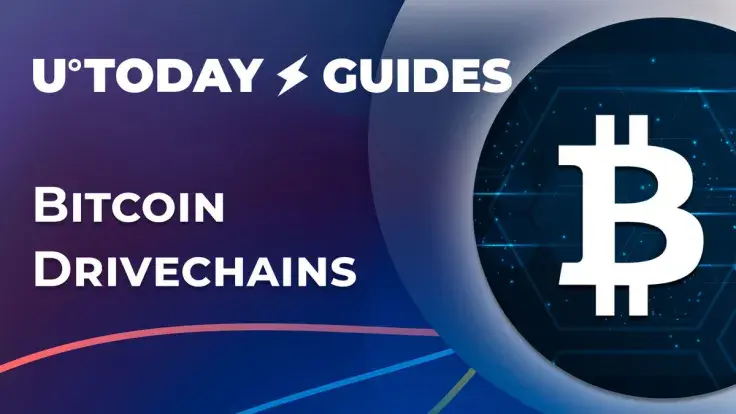
Bitcoin Drivechain, a concept of multiple autonomous second-layer sub-blockchains connected to the Bitcoin (BTC) mainnet, provoked heated debates among cryptocurrency developers, enthusiasts and investors.
Should it be approved, it might be the most radical change of the Bitcoin (BTC) network design since its launch in 2009. However, both supporters and critics of Drivechains have strong arguments for their positions.
What is Bitcoin Drivechain: Highlights
Initially introduced back in 2014 in the "Enabling Blockchain Innovations with Pegged Sidechains" thesis by Adam Back, Matt Coralo, Luke Dashjr and others, Bitcoin Drivechain mechanisms are yet another solution for Bitcoin (BTC) scaling and usability challenges.
- Bitcoin Drivechains are autonomous L2 blockchains on top of the Bitcoin (BTC) mainnet.
- Unlike Ethereum (ETH) rollups, every potential drivechain verifies its transactions separately and does not need L1 to add them to the mainnet.
- Assets can be moved between L1 and L2 through sophisticated mechanisms in order to keep the 1:1 peg between the two layers.
- Every drivechain can employ its own set of technical features, allowing developers to implement elements of DeFi logic to Bitcoin-based networks.
- Champions of Bitcoin Drivechains assure that the activation of this proposal will reintroduce Bitcoin (BTC) as a flexible and feature-rich part of digital economics, bring new liquidity, developers and investors to Bitcoin (BTC).
- Critics of Bitcoin Drivechains highlight the risks of such a radical hard fork and making Bitcoin (BTC) a new hotbed for scams and speculative altcoins as well as making Bitcoin (BTC) even more vulnerable to centralization.
Bitcoin Drivechain remains a hypothetical concept. Despite being proposed nine years ago, it is still in an early phase of the discussion timeline.
What is Bitcoin (BTC)?
Bitcoin (BTC) is the first blockchain and the largest cryptocurrency by market capitalization. The net market cap of its eponymous native asset exceeded $1.21 trillion at its peak registered in November 2021.
The Bitcoin (BTC) blockchain relies on the proof-of-work (PoW) consensus. It means that miners (operators of powerful computers connected to each other) are competing to find the hash of the next block and add it to the blockchain. For their contribution to the network, miners get periodical rewards of 6.25 Bitcoins (BTC) per block, or roughly once every 10 minutes.
Bitcoin's (BTC) technical design was proposed in 2009 by pseudonymous developer Satoshi Nakamoto. It paved the path for the concept of cryptocurrency itself and its viable realization.
What is sidechain?
Sidechains represent a subclass of blockchains (permissionless decentralized networks) that is built on top of the "maternal" blockchain. That said, every sidechain needs a certain "Layer 1" blockchain to exist. Typically, sidechains are more flexible than "large" blockchains and can be used for resource-efficient implementation of specific financial logic.
So far, both programmable and non-programmable blockchains are hosting sidechains for various purposes:
- Bitcoin (BTC) sidechains. Bitcoin is the parent chain for RSK and Liquid sidechain projects focused on DeFi features and streamlined payments.
- Ethereum (ETH) sidechains. One of the largest EVM blockchains, Polygon (MATIC) was initially introduced as an Ethereum (ETH) sidechain, not unlike Skale (SKL).
- Cardano (ADA) sidechains. The second largest proof-of-stake (PoS) network Cardano (ADA) also hosts several sidechains, including EVM-compatible ones. They are designed to solve the problem of Cardano-Ethereum interoperability.
As such, sidechains represent a kind of popular and flexible technology designed to make blockchains more scalable and functional.
What is Bitcoin Improvement Proposal (BIP)?
A Bitcoin Improvement Proposal or BIP is a formal proposal of an upgrade to the technical architecture of the Bitcoin (BTC) protocol. Since Bitcoin (BTC) is a fully open-source network, everyone can submit a proposal with some sort of technical change.
However, every BIP undergoes a sophisticated procedure of peer review by Bitcoin Core developers. Then, it can either be returned to the author or implemented in the blockchain network.
Image by U.Today
There are three main types of BIPs: consensus BIPs (changes to the key rules of how the Bitcoin (BTC) network exists), standard BIPs (proposals for new entities that can exist on blockchains), process BIPs (suggestions for how to streamline the Bitcoin (BTC) development and community discussions).
Here are some examples of crucial BIPs that changed the image of the Bitcoin (BTC) network for good.
Number | Proposed upgrade | Year of introduction |
BIPs 8-9 | Method of soft forks activation | 2017 |
BIP 39 | Mnemonic phrases for Bitcoin (BTC) wallets | 2018 |
BIP 142 | Segregated Witness (scaling technology) | 2015 |
BIP 174 | Partially Signed Bitcoin Transactions | 2017 |
BIP 340 | Schnorr signatures (security upgrade) | 2021 |
As such, by implementing BIPs, the Bitcoin (BTC) community adjusts the network to the changing context of the cryptocurrencies segment.
Understanding Bitcoin Drivechains: Unique opportunity or existential threat?
Bitcoin Drivechains are hypothetical sidechains on top of Bitcoin (BTC) designed to adopt specific financial logic.
Bitcoin Drivechains: Concept
Bitcoin Drivechain (or drive chain) is a way to scale the Bitcoin (BTC) network and equip it with an additional layer of functionality through launching an autonomous network connected to Bitcoin (BTC) in a bidirectional way.
Bitcoin Drivechain relies on two main technical mechanisms, i.e., hashrate escrow and blind merged mining. With hashrate escrows, a group of miners direct part of their hashrate (net number of hashes solved by their computers) to support a new network (drivechain).
With blind merged mining, Bitcoin (BTC) hashes from the mainnet can be reused to protect the integrity of "child chains."
The connection between the Bitcoin (BTC) main chain and drivechains is guaranteed by the ecosystem of the two-way peg: every coin can be moved freely between chains.
On Bitcoin Drivechains, developers can launch various protocols and even new generations of synthetic Bitcoin-based coins.
Bitcoin Drivechains: Inventors
As mentioned above, Bitcoin Drivechains (as a class of sidechains) were described by a group of top-level Bitcoin (BTC) developers Adam Back, Matt Corallo, Luke Dashjr, Mark Friedenbach, Gregory Maxwell, Andrew Miller, Andrew Poelstra, Jorge Timón and Pieter Wuille in 2014.
In 2017, Paul Sztorc proposed BIP 300 "Hashrate Escrows"; also, he proposed BIP 301 "Blind Merged Mining" two years later. In the two BIPs, Sztorc described two general components of how drivechains can operate and how they can connect to the Bitcoin (BTC) mainnet.
Finally, on Aug. 22, 2023, Bitcoin Core developer Luke Dashjr submitted a Drivechain Draft, i.e., a detailed description of how drivechains can be finally launched using a model similar to Bitcoin's UTXOs.
Bitcoin Drivechains: Benefits
Should Bitcoin Drivechains be implemented, the Bitcoin (BTC) network can become much more flexible and adjustable: developers will not need to implement a hard fork to activate an update for Bitcoin (BTC). It will be easier to change a drivechain (or launch a new one) than the Bitcoin (BTC) mainnet.
This, in turn, will mitigate competition with altcoins and eventually attract an inflow of liquidity to the Bitcoin (BTC) network. In some regard, Bitcoin (BTC) will become more attack-resistant: should an error occur in the Bitcoin (BTC) mainnet, drivechains will act as a backup layer.
With drivechains, Bitcoin (BTC) will be able to address previously unavailable use cases (derivatives, P2P exchanges, lending protocols and so on) and scale the largest blockchain without activating hard forks.
Bitcoin Drivechains: Risks
First of all, the implementation of drivechains can ruin the Bitcoin (BTC) ethos of a non-speculative cryptocurrency as there will be many "altcoins-on-Bitcoin." For some veteran Bitcoin (BTC) developers, this is the most painful possible outcome of the BIPs 300, 301 implementation.
Also, the design of "hashrate escrow" delegates too much power to Bitcoin (BTC) miners. They can easily initiate a 51% attack on a drivechain — that would be way easier than with the Bitcoin (BTC) mainnet — and drain its funds.
Luke Dasjr, one of the inventors of drivechain concept, is concerned about potential cheating opportunities for miners:
With the current state of mining centralisation, in my opinion, it would be pretty dumb to send any Bitcoins to a drivechain. There are better ways to burn bitcoins or donate to miners
Finally, some of the developers recall previous attempts to attach L2 functionality to Bitcoin, i.e., Taro, Ordinals, Lightning, Liquid and so on. None of them managed to gain global adoption. According to critics, drivechains will likely fail to find real use cases and demand from commercial apps.
Bottom line
Bitcoin Drivechains are isolated networks (sidechains) on top of the Bitcoin (BTC) mainnet with potential additional functionality. They will be connected to Bitcoin (BTC) via a two-way peg and will be protected by a random part of the Bitcoin (BTC) hashrate.
Drivechains were first described in 2014. Three years later, Paul Storcz released the first associated proposal, while in 2023 Luke Dasjr submitted a draft of its implementation for review.
Should it be adopted, Bitcoin (BTC) will be able to easily implement DeFi functionalities. However, the activation of drivechains results in certain security and centralization risks.
As Bitcoin's (BTC) development remains very conservative, it is uncertain when (or if) Bitcoin drivechains will be implemented as a mainnet upgrade. This proposal has existed for at least six years, but the hype around it has never been stronger.
 Arman Shirinyan
Arman Shirinyan Gamza Khanzadaev
Gamza Khanzadaev Godfrey Benjamin
Godfrey Benjamin Alex Dovbnya
Alex Dovbnya